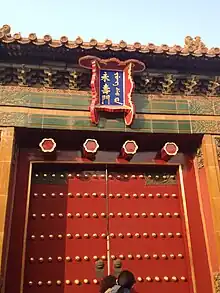Palace of Eternal Longevity
Palace of Eternal Longevity (Chinese: 永寿宫; pinyin: Yongshougong) is one of the Six Western Palaces in the Forbidden City. It was a residence of imperial concubines since 1420.

History
Yongshou Palace was built in 1420 as a part of Inner Court's western palaces and named "Palace of Eternal Pleasure" (长乐宫, pinyin: Changle gong). In 1535, the Jiajing Emperor renamed the palace as "Palace of Embodying Morality" (毓德宫, pinyin: yudegong). In 1616, the palace obtained its current name. Yongshou Palace was undergoing renovations in 1697 and 1897.[1] During the Qianlong period, the palace was used as a place of wedding banquets for Princess Heke of the Second Rank in 1772[2] and Gurun Princess Hexiao in 1789.[3] During the Daoguang era, rear halls of the palace became a storage of classified intelligence.
It is the closest palace to Yangxin hall, the residence of Qing dynasty emperors from 1722.
Residents
Ming dynasty
| Year | Emperor | Imperial consort | Note |
|---|---|---|---|
| 1466-1475 | Chenghua | Empress Dowager Xiaomuji[4] | |
| 1638-1643 | Chongzhen | The palace was used as a shelter
from natural disasters |
Qing dynasty
| Date | Emperor | Imperial consort | Note |
|---|---|---|---|
| 25.10.1653 | Shunzhi | Erdeni Bumba | Borjigit Erdeni Bumba was demoted to Consort Jing,
thus she moved from Kunning Palace to Yongshou Palace. |
| July 1657 – 1667 | Consort Ke | She was holding the title of Noble Lady
and was promoted to Consort in 1667[5] | |
| 28.12.1682-19.12.1694 | Kangxi | Noble Consort Wenxi | |
| ?-20.08.1699 | Imperial Noble Consort Jingmin | ||
| 1675-1711 | Consort Liang | ||
| 1735 | Yongzheng | Empress Xiaoshengxian | She lived there shortly before moving
to Shoukang Palace as Empress Dowager |
| January 1742-4.07.1777 | Qianlong | Consort Shu | She moved there after being promoted
to concubine and supervised lesser-ranking consorts. |
| 1757-29.05.1784 | Concubine Cheng | She died during the southern tour in 1784 | |
| 1766-1788 | Noble Lady Shun | She supervised younger consorts from 1777 to 1788 | |
| 1766-1794 | Consort Fang | She moved out from the palace in 1794[6] | |
| 1801-1821 | Jiaqing | Imperial Noble Consort Gongshun[7] | She moved out to Shou'an Palace in 1821 |
References
- "永寿宫 - 故宫博物院". www.dpm.org.cn. Retrieved 2020-08-15.
- "清會典".
- Aisin Gioro, Zhaolian. "Continued Records of the Roaring Pavilion".
- "History of Ming. Biographies of imperial consorts". Book 113.
- "永平府志".
- "乾隆至嘉慶年添減底檔"/"Archives of Qianlong and Jiaqing eras".
- "Palace of Eternal Longevity (Yongshou gong)|The Palace Museum". en.dpm.org.cn. Retrieved 2020-08-15.